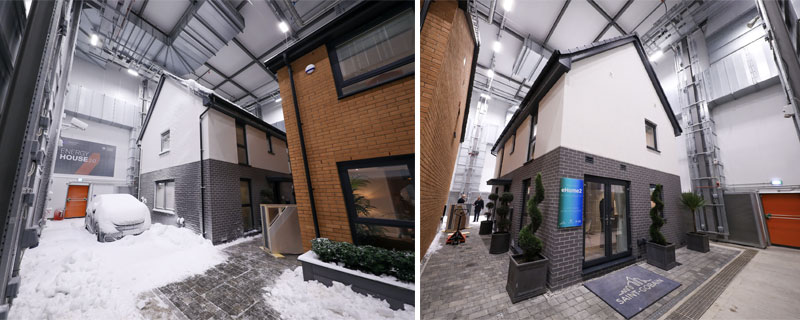A concept house built with a new off-site system and additional materials supplied by Saint-Gobain Off-Site Solutions will soon enter a testing period, as part of a project designed to accelerate progress towards low carbon and net zero housing.
The pioneering eHome2 is a three-bedroom family home built inside the world-leading Energy House 2.0 climatic chamber facility at Salford University. Over a period of nine months, the house will undergo rigorous whole-building testing – including thermal performance, energy efficiency, running costs and residential comfort, as well as its ability to cope with extreme temperatures and climatic conditions.
The house was built using a combination of off-site modern methods of construction, with Saint-Gobain Off-site Solutions brands Scotframe and Pasquill supplying advanced timber frame products and factory-installed pre-insulated walls.
eHome2, a collaborative partnership between housebuilder Barratt Developments, Saint-Gobain Off-Site Solutions, and additional brands within the Saint-Gobain UK & Ireland group, seeks to change the way we build high-quality, sustainable and future-ready new homes in the UK.
As such, the data gathered from eHome2, which in itself is operationally net zero, will help inform how the housebuilding sector will design and build zero-carbon housing at scale using sustainable building materials and off-site solutions.
Futureproofing with Posi-Joists
Manufactured and assembled at Pasquill’s flagship Chorley site, the floor cassettes supplied to eHome2 are a timber frame construction which add to the sustainability credentials of the build.
As the project is being built to exceed Future Home Standards requirements, it has been designed to accommodate many more heating, ventilation and renewable energy services than the houses commonly built today. Pasquill’s Posi-Joist™️ cassettes’ metal webbed design creates a larger service void, allowing for easy and free routeing of utilities such as Mechanical Ventilation and Heat Recovery systems (MVHR) throughout the home.
These top-hung Posi-Joist floor cassettes also help speed up the process of installation and reduce the thermal bridging at wall-floor interfaces.
Pasquill has also supplied the Roof Trusses for eHome2 in order to help create a thermally efficient attic space. Combining traditional Trusses with Attic Trusses has created a space that can also house additional services and pipework required to run future smart homes. Both the Posi-Joist cassettes and the Roof Truss systems add to the pre-manufactured value of the eHome2 build.
Thermally efficient panellised solution
eHome2 features a new proposed MMC category 2 closed panel solution from Scotframe. The wall panel system, which is assembled with BRE A+ rated Isover mineral wool between the i-stud based timber frame, provides maintenance-free and long-lasting insulation. This cuts energy bills, while innovative connections reduce thermal bridging design and enhance airtightness.
With the inclusion of critical vapour control membranes, service zones and externally fitted battens, the system speeds up on-site build time and ensures a high-performing fabric – achieving 0.13 W/m2k.
The result is a solution with a performance point that exceeds Future Home Standard requirements without the need for additional site-installed installation. It also means that the house can be erected from the slab to the finished roof in only two weeks, including cladding and windows.
Similarly, Scotframe’s system also delivers high levels of premanufactured value, with a reduced reliance on on-site labour and a reduction of on-site waste.
Next generation housing
Ross Baxter, Managing Director, Saint-Gobain Off-Site Solutions, said: “eHome2 is an investment in the future of UK housing, and has the potential to completely revolutionise how we design and build homes. The fact so many organisations are working together towards a common goal shows that collaboration undoubtedly is the best way for us to tackle the challenges facing the industry.
“It’s our aim to help national housebuilders and other volume housing providers find a way of delivering zero-carbon homes of the future at scale and speed. The project is a brilliant showcase of how off-site manufacturing can help achieve this, with innovative solutions driven by sustainability and performance that can help make the world a better home.”
Tom Cox, Technical and Development Director, Saint-Gobain Off-Site Solutions, said: “This project is a fantastic demonstration of how off-site can deliver a high premanufactured value to housing developers. In particular, our brands Pasquill and Scotframe have made a significant contribution, with innovative timber-engineered panels and cassettes which have sped up the build and increased its sustainability credentials.
“When working with the Barratt design team on the project, designers chose to use the Posi-Joist™️ cassette system to allow for easy rooting of utilities, which are required for future homes design. Meanwhile, the new panel system itself has also had a number of tests carried out on it so it’s looking like it’s going to be quite an exciting solution for developers moving forward.”
Energy House 2.0 is a £16 million testing facility that is part-funded by the European Regional Development Fund and harnesses the University of Salford’s expertise in climate and the built environment.
Completed in February this year, the facility is the largest of its kind in the world, with two chambers which can accommodate two detached homes. These chambers can replicate weather conditions including rain, wind, snow and solar radiation, with temperatures ranging from -20 degrees to +40 degrees centigrade.
eHome2 features a range of sustainable building products and materials from Saint-Gobain brands including British Gypsum, Isover, Saint-Gobain Glass and Weber.
CLICK HERE For more information on the project






Leave a Reply
Want to join the discussion?Feel free to contribute!